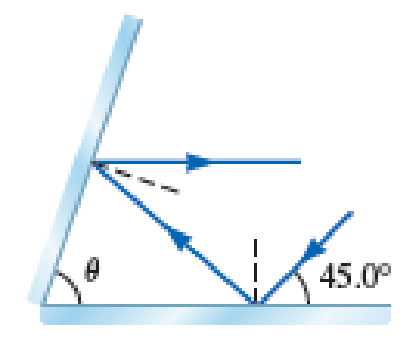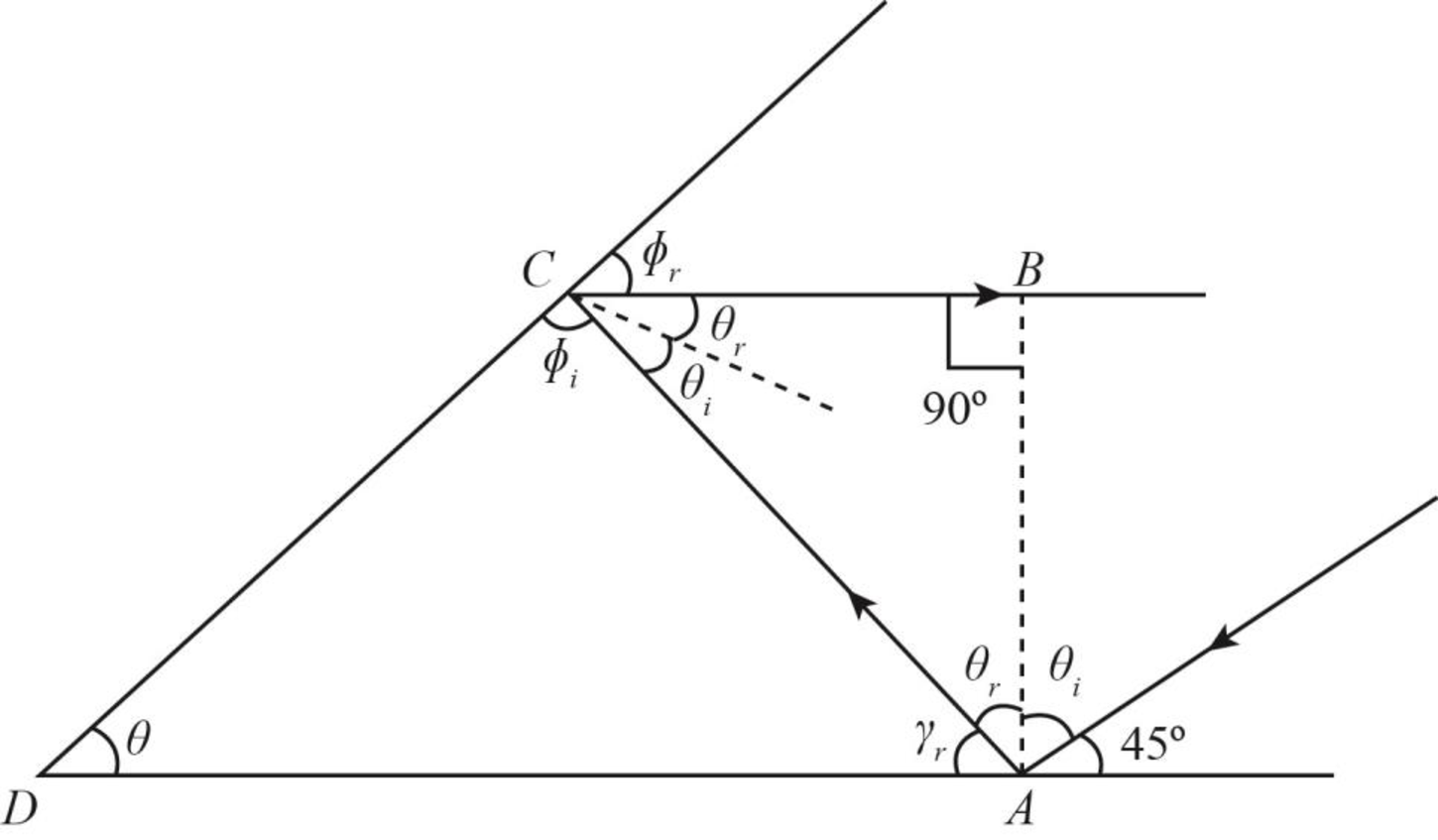
Concept explainers
Light rays strike a plane mirror at an angle of 45.0° as shown in Figure P37.15. At what angle should a second mirror be placed so that the reflected rays are parallel to the first mirror?

The angle at which the second mirror be placed so that the reflected rays are parallel to the first mirror.
Answer to Problem 15PQ
The angle at which the second mirror be placed so that the reflected rays are parallel to the first mirror is
Explanation of Solution
The following figure shows the reflection diagram.

Figure-(1)
Here,
Calculate the angle from the above diagram.
According to law of reflection
Calculate the other angles from the above diagram.
From the above figure, the total angle in the triangle
For the second mirror, the total angle in a straight line is equal to
From the above figure, the total angle in the triangle
Conclusion:
Substitute
Substitute
Substitute
Substitute
Therefore, the angle at which the second mirror be placed so that the reflected rays are parallel to the first mirror is
Want to see more full solutions like this?
Chapter 37 Solutions
Physics for Scientists and Engineers: Foundations and Connections
- Please solve and answer the question correctly. Thank you!! (Hint in second photo)arrow_forwardplease solve and answer the question correctly. Thank you!!arrow_forwardAssuming the normal angle for stairs in a house, 37.0˚ with the horizontal, what is Kevin’s acceleration down the stairs? The sled is always touching at least one stair so you can treat it the same as a ramp. The coefficient of kinetic friction between the sled and the carpeted stairs is 0.708.arrow_forward
- A helicopter pulls up and back on the truck with a force of 5.78⋅10^4 N at an angle of 30.0˚ from the horizontal. The truck has a mass of 5.04⋅10^3 kg. The truck’s engine applies a force on the truck that is in the x direction causing the truck to accelerate at 2.09 m/s2 in x. A) What is the force the engine is exerting? B) What is the normal force acting on the truck? Assume no acceleration in y.arrow_forwardMikasa and her allies, from Attack on Titan, uses omni-directional mobility gear (ODM gear) to move from place to place. The ODM gear launches out wires with grappling hooks they can use to swing through the city. Mikasa, who has a mass of 68.0 kg, holds herself in place not moving with two wires from the ODM gear, as shown below with θ1 = 39.3°. If the tension in the wire labeled T1 is 688 N, what tension, magnitude and direction, is needed in T2?arrow_forwardDoctor Strange’s cloak allows him to levitate, and glide forward. Dr. Strange’s cloak does this by applying a F at an angle of 70.0˚, A) What force must the cloak be exerting to keep a Dr. Strange at a set height, neither lowering nor rising? Dr. Strange has a weight of 147 lbs. (2.20 lb = 1 kg). B) When the force found in part A is applied, what is Dr. Strange’s acceleration?arrow_forward
- please solve and answer the question correctly. Thank you!!arrow_forwardplease solve and answer the question correctly. Thank you!! ( Hint attached in second photo)arrow_forwardA) If the lightsaber has a mass of 2.14 kg, what minimum force would be required to pull the lightsaber to her, assuming it does not leave the table’s surface and the force is completely horizontal? The coefficient of static friction is 0.300 and the coefficient of kinetic friction is 0.173. B) What acceleration does the lightsaber have when it starts moving? Assume Rey is pulling with the same force you found in Aarrow_forward
 Physics for Scientists and EngineersPhysicsISBN:9781337553278Author:Raymond A. Serway, John W. JewettPublisher:Cengage Learning
Physics for Scientists and EngineersPhysicsISBN:9781337553278Author:Raymond A. Serway, John W. JewettPublisher:Cengage Learning Physics for Scientists and Engineers with Modern ...PhysicsISBN:9781337553292Author:Raymond A. Serway, John W. JewettPublisher:Cengage Learning
Physics for Scientists and Engineers with Modern ...PhysicsISBN:9781337553292Author:Raymond A. Serway, John W. JewettPublisher:Cengage Learning Principles of Physics: A Calculus-Based TextPhysicsISBN:9781133104261Author:Raymond A. Serway, John W. JewettPublisher:Cengage Learning
Principles of Physics: A Calculus-Based TextPhysicsISBN:9781133104261Author:Raymond A. Serway, John W. JewettPublisher:Cengage Learning Physics for Scientists and Engineers: Foundations...PhysicsISBN:9781133939146Author:Katz, Debora M.Publisher:Cengage Learning
Physics for Scientists and Engineers: Foundations...PhysicsISBN:9781133939146Author:Katz, Debora M.Publisher:Cengage Learning Physics for Scientists and Engineers, Technology ...PhysicsISBN:9781305116399Author:Raymond A. Serway, John W. JewettPublisher:Cengage Learning
Physics for Scientists and Engineers, Technology ...PhysicsISBN:9781305116399Author:Raymond A. Serway, John W. JewettPublisher:Cengage Learning University Physics Volume 3PhysicsISBN:9781938168185Author:William Moebs, Jeff SannyPublisher:OpenStax
University Physics Volume 3PhysicsISBN:9781938168185Author:William Moebs, Jeff SannyPublisher:OpenStax





